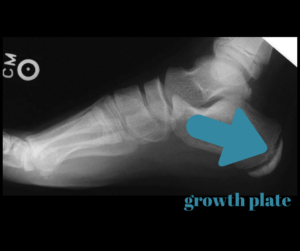I find it so interesting that when babies are born that they do not have bones in their feet. To think that the feet have so many bones and yet babies don’t have any of them formed at birth is amazing. Just think of all those little bones growing as a child grows. Our bodies are just so cool.
Of course, as the body grows and those little bones form, there can occasional be problems. One such problem is Sever’s disease.
(In case you are wondering, this disease has nothing to do with Tom Seaver the baseball player. It is named after James Warren Sever the doctor who identified the disease.)
Children have growth plates at both ends of their long bones. These growth plates leave room for the bones to grow while the child grows. The growth plates are the weakest area of a growing skeleton. They are weaker than the tendons and ligaments that are around them. Due to this weakness, they are vulnerable to injury. At some point during adolescence the growth plates are replaced by solid bone.
During a period of rapid growth, it is possible that the heel bone will grow faster than the leg muscles and tendons around it. When this happens, the tendons and ligaments can get over stretched and that makes the heel less flexible. The Achilles tendon is the strongest tendon that attached to the growth plate in the heel. When it is strained, it will become less flexible. This lack of flexibility will, in turn, put pressure on the growth plate. As a result of this lack of flexibility and pressure, there can be swelling, tenderness or pain in the heel.
Physical activities involving running and jumping are particularly hard when a child has Sever’s disease. This means that sports like basketball, track, soccer, and gymnastics can become painful. If your child is experiencing pain in their foot, it is not the time to tell them to “play through it.” You need to take your child to see your friendly local podiatrist to have them checked.
With Sever’s disease, your child’s heel could be swollen or look red. Another sign is if your child has difficulty walking because their heel hurts. It could be that they are walking on their tiptoes or they are limping to avoid putting pressure on the heel that hurts. It may be that they feel some mild pain or stiffness when they get out of bed in the morning or discomfort when their heel is squeezed on both sides. The pain or discomfort that they feel will usually get better after they stop doing the activity.
When you take your child to the doctor, the doctor will ask questions and do an exam of the foot and heel. The doctor could ask your child to stand on his/her tiptoes to see if that causes discomfort. The doctor may have an x-ray done just to rule out any broken bones.
Sever’s disease is an overuse disease so the first thing that a child with it needs to do is rest until the pain is gone. To help ease the pain, your doctor might suggest some stretches to help strengthen and stretch the tendons. Using a wrap like an Ace bandage could help keep the get the swelling down. Elevation and ice on the heel can help reduce the pain and swelling. In severe cases, the doctor might decide to cast the area so it can heal.
Your friendly local podiatrist will be happy to check your child and explain all their recommendations to you. I know it will be hard to keep an active child resting for recovery time but hopefully it will heal very quickly.



